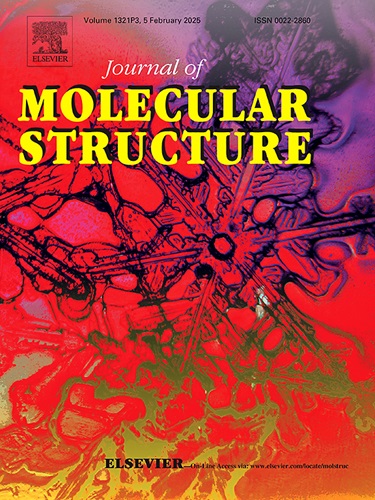Pd-TiO2/ZnFe2O4光催化剂在日光照射下光催化降解环丙沙星
IF 4
2区 化学
Q2 CHEMISTRY, PHYSICAL
引用次数: 0
摘要
本研究报道了通过直接水热合成和热分解制备Pd-TiO₂/ZnFe₂O₄纳米复合材料。利用x射线衍射(XRD)、傅里叶变换红外光谱(FT-IR)、x射线光电子能谱(XPS)、扫描电子显微镜(SEM)、能量色散x射线(EDX)、元素映射、uv -可见漫反射光谱(UV-DRS)和光致发光(PL)分析等技术对合成材料的结构、形态和光学特性进行了研究。与纯tio2相比,pd - tio2 /ZnFe₂O₄纳米复合材料在紫外和可见光区域均表现出增强的光吸收。通过辐照降解环丙沙星,考察了其光催化效率。该复合材料对TiO 2和TiO 2 /ZnFe₂O₄表现出优异的降解性能,在中性pH下达到最佳效果(7)。此外,该催化剂在连续5次重复使用循环中保持了其稳定性和活性。这些发现突出了Pd-TiO₂/ZnFe₂O₄作为一种高效的太阳能驱动光催化剂在废水处理中的应用潜力。本文章由计算机程序翻译,如有差异,请以英文原文为准。

Pd-TiO2/ZnFe2O4 photocatalyst for photocatalytic degradation of ciprofloxacin under solar light irradiation
This study reports the preparation of a Pd-TiO₂/ZnFe₂O₄ nanocomposite via a straightforward hydrothermal synthesis followed by thermal decomposition. The structural, morphological, and optical characteristics of the synthesized material were examined using techniques such as X-ray diffraction (XRD), Fourier-transform infrared spectroscopy (FT-IR), X-ray photoelectron spectroscopy (XPS), scanning electron microscopy (SEM), energy dispersive X-ray (EDX), elemental mapping, UV–visible diffuse reflectance spectroscopy (UV-DRS), and photoluminescence (PL) analysis. The Pd-TiO₂/ZnFe₂O₄ nanocomposite exhibited enhanced light absorption across both UV and visible regions in comparison to pure TiO₂. Its photocatalytic efficiency was tested by degrading ciprofloxacin under irradiation. The composite demonstrated superior degradation performance over TiO₂ and TiO₂/ZnFe₂O₄, achieving the best results at neutral pH (7). Additionally, the catalyst retained its stability and activity over five consecutive reuse cycles. These findings highlight the potential of Pd-TiO₂/ZnFe₂O₄ as an efficient solar-driven photocatalyst for wastewater treatment applications.
求助全文
通过发布文献求助,成功后即可免费获取论文全文。
去求助
来源期刊

Journal of Molecular Structure
化学-物理化学
CiteScore
7.10
自引率
15.80%
发文量
2384
审稿时长
45 days
期刊介绍:
The Journal of Molecular Structure is dedicated to the publication of full-length articles and review papers, providing important new structural information on all types of chemical species including:
• Stable and unstable molecules in all types of environments (vapour, molecular beam, liquid, solution, liquid crystal, solid state, matrix-isolated, surface-absorbed etc.)
• Chemical intermediates
• Molecules in excited states
• Biological molecules
• Polymers.
The methods used may include any combination of spectroscopic and non-spectroscopic techniques, for example:
• Infrared spectroscopy (mid, far, near)
• Raman spectroscopy and non-linear Raman methods (CARS, etc.)
• Electronic absorption spectroscopy
• Optical rotatory dispersion and circular dichroism
• Fluorescence and phosphorescence techniques
• Electron spectroscopies (PES, XPS), EXAFS, etc.
• Microwave spectroscopy
• Electron diffraction
• NMR and ESR spectroscopies
• Mössbauer spectroscopy
• X-ray crystallography
• Charge Density Analyses
• Computational Studies (supplementing experimental methods)
We encourage publications combining theoretical and experimental approaches. The structural insights gained by the studies should be correlated with the properties, activity and/ or reactivity of the molecule under investigation and the relevance of this molecule and its implications should be discussed.
 求助内容:
求助内容: 应助结果提醒方式:
应助结果提醒方式:


